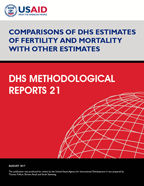
Abstract:
DHS surveys provide many indicators that are used for program planning and monitoring. Some of these are particularly sensitive and attract attention when the results of a new survey are released. This methodological report focuses on six demographic indicators of widespread interest: the Total Fertility Rate (TFR), Infant Mortality Rate (IMR), Under-five Mortality Rate (U5MR), the Adult Female Mortality Rate (AFMP), the Adult Male Mortality Probability (AMMP) and the Maternal Mortality Ratio (MMR). It is not unusual for the results of a new survey to be questioned because they differ from another source. The goal of this report is to provide guidance on how to determine whether the estimates of these important indicators are plausible and consistent with other sources, or not plausible.
Determining whether a DHS estimate is consistent with other sources is usually a matter of degree. Some differences are expected for a variety of reasons. The report includes a discussion of potential reasons for discrepancies. The report then analyzes 51 surveys conducted since 2010. The DHS estimates are systematically compared with estimates of the TFR, AFMP, and AMMP from the UN Population Division, estimates of the IMR and U5MR from the UN’s Inter Agency Group for Child Mortality Estimation (IGME), and MMR estimates from the World Health Organization (WHO). The structure of the comparisons can be applied to other sources, although it is always necessary to account for the potential kinds of differences discussed earlier. Two specific surveys provide focus for the comparisons.
The report also illustrates a strategy for comparing fertility rates computed from DHS data with those from other sources. We compare DHS fertility rate estimates with those from Performance Monitoring and Accountability 2020 (PMA2020) surveys, explore the effect of a slightly different methodology for computing rates on DHS estimates, and simulate the effects of a different sampling strategy and rate estimation method on fertility rates. Using a standard methodology, fertility rates computed from PMA2020 data in five countries showed a range of 5% to 22% difference in TFRs and a 4% to 17% difference in adolescent fertility rates compared to results from DHS surveys conducted within a three-year timespan.
To assess the effect of alternate measurement on fertility rates from the exact same survey, we used 256 DHS datasets to compare the results of a 2-year 2-birth adjusted estimation technique versus a 3-year n-birth technique with the same data. Our results show an average of only about one percentage point difference in total fertility and adolescent fertility rates from the same data using the alternate technique. In addition to measurement differences, it is important to consider design effects of a different cluster sample. In Ethiopia, we simulated subsamples of DHS data with a cluster distribution similar to a corresponding PMA2020 survey and recomputed fertility rates with a 2-year 2-birth adjusted estimation technique. These combined differences in sampling and methodology produced an average of between 3 to 4% difference in rate estimates but could plausibly produce as much as a 10% difference in TFR and a 23% difference in adolescent fertility rates. Notably, since the PMA2020 cluster sample sizes are larger than those used by DHS, this simulation is likely an overestimate of the effect of sampling differences.
 Comparisons of DHS Estimates of Fertility and Mortality with Other Estimates (PDF, 1265K)
Comparisons of DHS Estimates of Fertility and Mortality with Other Estimates (PDF, 1265K)
